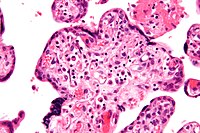
Photo from wikipedia
ABSTRACT Despite the efforts in developing therapeutics for stroke, recombinant tissue plasminogen activator (rtPA) remains the only FDA approved drug for ischemic stroke. Regenerative medicine targeting endogenous growth factors has… Click to show full abstract
ABSTRACT Despite the efforts in developing therapeutics for stroke, recombinant tissue plasminogen activator (rtPA) remains the only FDA approved drug for ischemic stroke. Regenerative medicine targeting endogenous growth factors has drawn much interest in the clinical field as it provides potential restoration for the damaged brain tissue without being limited by a narrow therapeutic window. To date, most of the translational studies using regenerative medicines have encountered problems and failures. In this review, we discuss the effects of some trophic factors which include of erythropoietin (EPO), brain derived neurotrophic factor (BDNF), granulocyte‐colony stimulating factor (G‐CSF), vascular endothelial growth factor (VEGF), fibroblast growth factor (FGF), epidermal growth factor (EGF) and heparin binding epidermal growth factor (HB‐EGF) in experimental ischemic stroke models and elaborate the lost in translation of the candidate growth factors from bench to bedside. Several new methodologies have been developed to overcome the caveats in translational studies. This review highlights the latest bioengineering approaches including the controlled release and delivery of growth factors by hydrogel‐based scaffolds and the enhancement of half‐life and selectivity of growth factors by a novel approach facilitated by glycosaminoglycans. HIGHLIGHTSRegenerative medicine as the ischemic stroke treatment has attracted great attention recently since it promotes potential regeneration and repair to the damaged brain tissue without being limited by the narrow therapeutic window.Despites a large body of studies in experimental animal models suggests growth factors like BDNF, VEGF, FGF, EGF, EPO and G‐CSF may be both neuroprotective and neuroregenerative to stroke, growth factors involving in clinical trials are by far disappointing.Hence several attempts have been developed to optimize growth factors for stroke treatment.In this review, we highlight the controlled release of growth factor hydrogel based scaffolds, targeted delivery to the brain and glysominoglycan chemistry that enhance the half life and selectivity of the growth factors.
Journal Title: Neurochemistry International
Year Published: 2017
Link to full text (if available)
Share on Social Media: Sign Up to like & get
recommendations!